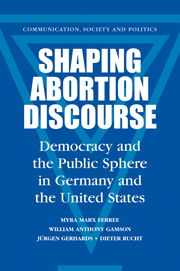Book contents
- Frontmatter
- Contents
- Tables and Figures
- Foreword by Friedhelm Neidhardt
- Preface
- Glossary
- Part I Introduction
- Part II Major Outcomes
- Part III Representing Different Constituencies
- Part IV The Quality of Abortion Discourse
- 10 Normative Criteria for the Public Sphere
- 11 Measuring the Quality of Discourse
- 12 Metatalk
- 13 Lessons for Democracy and the Public Sphere
- Methodological Appendix
- References
- Index
11 - Measuring the Quality of Discourse
Published online by Cambridge University Press: 15 December 2009
- Frontmatter
- Contents
- Tables and Figures
- Foreword by Friedhelm Neidhardt
- Preface
- Glossary
- Part I Introduction
- Part II Major Outcomes
- Part III Representing Different Constituencies
- Part IV The Quality of Abortion Discourse
- 10 Normative Criteria for the Public Sphere
- 11 Measuring the Quality of Discourse
- 12 Metatalk
- 13 Lessons for Democracy and the Public Sphere
- Methodological Appendix
- References
- Index
Summary
In this chapter we analyze empirically the three sets of questions raised in the previous chapter – who speaks, how and what they communicate, and what is the outcome of the discourse – to compare the extent to which the normative criteria of the different theoretical traditions are met in Germany and the United States.
THE INCLUSION ISSUE
Who speaks? We have already operationalized this with the concept of standing and have largely answered it in Chapter Five (summarized in Table 5.1). State and party actors are 75% of the speakers in Germany compared to 40% in the United States. The residual 25% in Germany is given over mainly to the Catholic and Lutheran churches and to experts, with a negligible 2% going to Pro and Anti movement organizations. The discourse focuses heavily on legislative and judicial actions, keeping citizens well informed about what their representatives are doing. This discourse looks very much like what the representative liberal model would consider ideal.
In the United States, in contrast, state and party actors are a minority and Pro and Anti movement organizations make up about one-quarter of all speakers. The U.S. newspapers are three times as likely as German newspapers to quote individuals who are not spokespersons for anyone but themselves. U.S. discourse is slightly higher in including experts (6%, versus 4% in Germany), but experts are practically the only individuals who are quoted in Germany. They are only 40% of the individuals with standing in the United States.
- Type
- Chapter
- Information
- Shaping Abortion DiscourseDemocracy and the Public Sphere in Germany and the United States, pp. 232 - 254Publisher: Cambridge University PressPrint publication year: 2002

